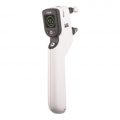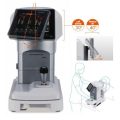-
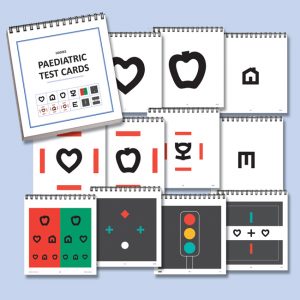 Collection of 66 test cards for use during examination of children. Hanks Pediatric Optotypes - Calibrated from 6/60 to 6/4. Designed for this purpose and tested in clinical trials to confirm recognition of the symbols by young children. Landolt C & Illiterate E Optotypes are also included - Calibrated from 6/60 to 6/4. Color Vision Screening - Pseudo-isochromatic plates with letters, numbers, circles and trails. Quality Production - Each card is matt laminated and encapsulated for long life protection. Actual size of each card is 108 x 112mm. Item #: AUPTC
Collection of 66 test cards for use during examination of children. Hanks Pediatric Optotypes - Calibrated from 6/60 to 6/4. Designed for this purpose and tested in clinical trials to confirm recognition of the symbols by young children. Landolt C & Illiterate E Optotypes are also included - Calibrated from 6/60 to 6/4. Color Vision Screening - Pseudo-isochromatic plates with letters, numbers, circles and trails. Quality Production - Each card is matt laminated and encapsulated for long life protection. Actual size of each card is 108 x 112mm. Item #: AUPTC -
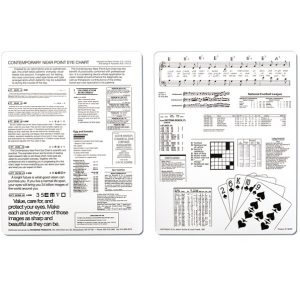 This sturdy 8.5" x 11" chart was created by an MD and OD to show most common task using your eyes. It can be used to screen for visual difficulties as well as demonstrate needs. Good for use in the exam room as well as the workup and dispensing rooms.
This sturdy 8.5" x 11" chart was created by an MD and OD to show most common task using your eyes. It can be used to screen for visual difficulties as well as demonstrate needs. Good for use in the exam room as well as the workup and dispensing rooms. -
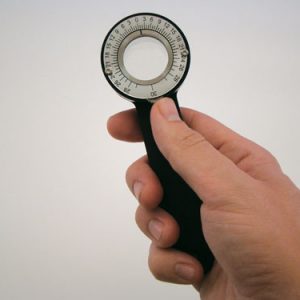
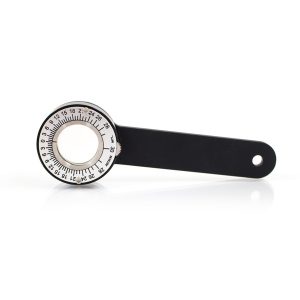 An affordable Risley Prism that you can use for testing. This prism allows variable prism demand up to 30PD. A prism before each eye can increase the demand of 60PD. The prism is approximately 1" diameter. Item #: ARPHH30
An affordable Risley Prism that you can use for testing. This prism allows variable prism demand up to 30PD. A prism before each eye can increase the demand of 60PD. The prism is approximately 1" diameter. Item #: ARPHH30 -
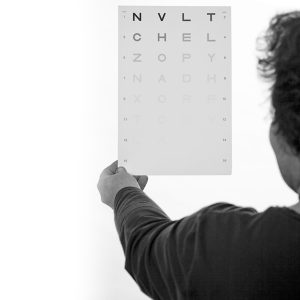
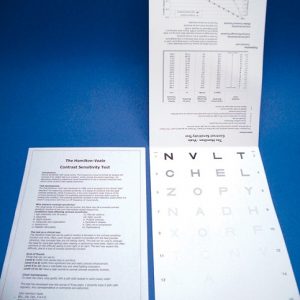 Hamilton-Veale Contrast Sensitivity Test This easy and convenient test can be used to monitor a decrease on the contrast sensitivity function over time. This test also demonstrates the difficulty of seeing in poor lighting or at night.
Hamilton-Veale Contrast Sensitivity Test This easy and convenient test can be used to monitor a decrease on the contrast sensitivity function over time. This test also demonstrates the difficulty of seeing in poor lighting or at night. -
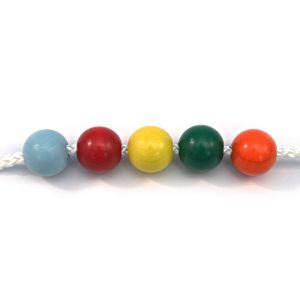 Some doctors prefer the size and feel of these string units over the Bernell ones above. These have Red, Green, Yellow, Blue, and Orange beads. Item #: FR+
Some doctors prefer the size and feel of these string units over the Bernell ones above. These have Red, Green, Yellow, Blue, and Orange beads. Item #: FR+ -
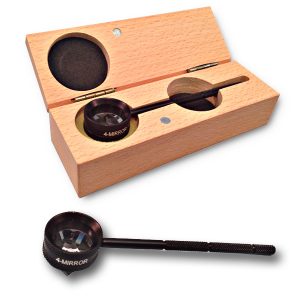 This 4 mirror glass lens is used for viewing all quadrants of the anterior chamber without lens repositioning. Mirrors are placed at angles of 62 degrees. No flange. No fluid required. Removable handle screws into place. Lens diameter: 20mm Rim Diameter: 25mm Lens Contact Point: 9mm Comes with padded case Item #: AMPDSG
This 4 mirror glass lens is used for viewing all quadrants of the anterior chamber without lens repositioning. Mirrors are placed at angles of 62 degrees. No flange. No fluid required. Removable handle screws into place. Lens diameter: 20mm Rim Diameter: 25mm Lens Contact Point: 9mm Comes with padded case Item #: AMPDSG -
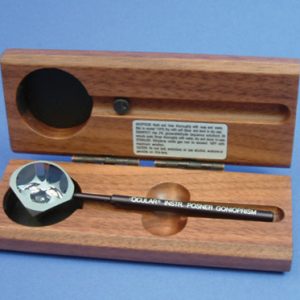
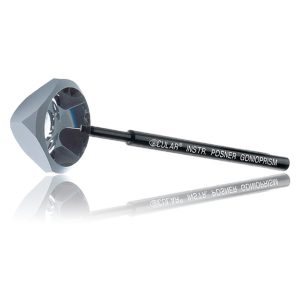 Ideal for use with children or patients with a small palpebral fissure. The instrument consists of a highly polished truncated silver surfaced pyramid with a plane anteroir viewing surface over four mirrors. An aluminum handle set at 35 degrees is bonded to one corner of the lens. The lens is used in the diamond position (45 degrees) resulting in fewer adjustments of lowering and elevating the slit beam with either hand. Item #: OCIOPDSG
Ideal for use with children or patients with a small palpebral fissure. The instrument consists of a highly polished truncated silver surfaced pyramid with a plane anteroir viewing surface over four mirrors. An aluminum handle set at 35 degrees is bonded to one corner of the lens. The lens is used in the diamond position (45 degrees) resulting in fewer adjustments of lowering and elevating the slit beam with either hand. Item #: OCIOPDSG -
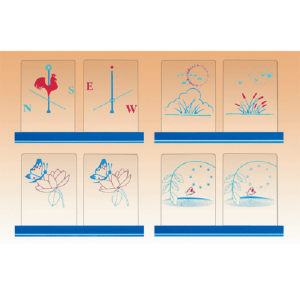 Fusional training 4 card pairs set suitable to develop ocular coordination, by establishing a flexible interaction in accommodative-vergence system through 4 card pair level. Polycarbonate material, sliding track included. Item #: E/FC
Fusional training 4 card pairs set suitable to develop ocular coordination, by establishing a flexible interaction in accommodative-vergence system through 4 card pair level. Polycarbonate material, sliding track included. Item #: E/FC -
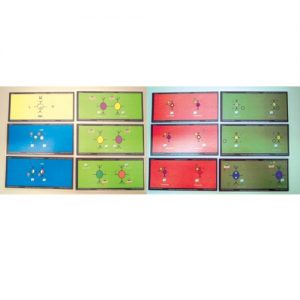 Aperture Rule™ Set (12 Stereoscope sized cards) These cares are more complex and require more detail demand. They build flexibility, resiliency, attention to detail and reduction of visual fatigue. These cards contain large quantities of details and build large ranges of fusion (leading to high amounts of prism diopters of 'Base Out' and 'Base In' fusion ranges) 12 Cards
Aperture Rule™ Set (12 Stereoscope sized cards) These cares are more complex and require more detail demand. They build flexibility, resiliency, attention to detail and reduction of visual fatigue. These cards contain large quantities of details and build large ranges of fusion (leading to high amounts of prism diopters of 'Base Out' and 'Base In' fusion ranges) 12 Cards -
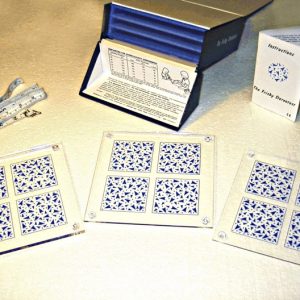 All Frisby Stereo Test Present "real depth" objects viewed with natural vision: no testing glasses are required. Each plate has four random-pattern squares with a circle of pattern elements lying in depth relative to its surround. The depth effect is due to the circle and its surround being printed on opposite sides of the plate. The Frisby Stereo Test has 3 plates allowing for testing stereo acuity disparity as fine as 15 seconds of arc.
All Frisby Stereo Test Present "real depth" objects viewed with natural vision: no testing glasses are required. Each plate has four random-pattern squares with a circle of pattern elements lying in depth relative to its surround. The depth effect is due to the circle and its surround being printed on opposite sides of the plate. The Frisby Stereo Test has 3 plates allowing for testing stereo acuity disparity as fine as 15 seconds of arc. -
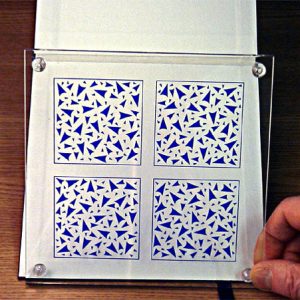 All Frisby Stereo Test Present "real depth" objects viewed with natural vision: not testing glasses are required. Each plate has four random-patten squares, with a circle of pattern elements, lying in depth relative to its surround. The depth effect is due to the circle and its surround being printed on opposite sides of the plate. The purpose of the Frisby Screening Stereo Test - Single Plate, is to demonstrate the presence of stereopsis.
All Frisby Stereo Test Present "real depth" objects viewed with natural vision: not testing glasses are required. Each plate has four random-patten squares, with a circle of pattern elements, lying in depth relative to its surround. The depth effect is due to the circle and its surround being printed on opposite sides of the plate. The purpose of the Frisby Screening Stereo Test - Single Plate, is to demonstrate the presence of stereopsis. -
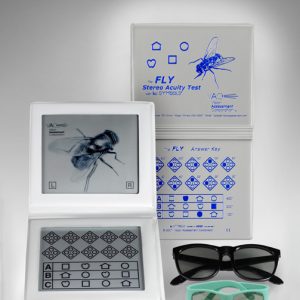
Designed to rapidly test for amblyopia and strabismus using gross thru fine stereopsis (4800 to 20 seconds of arc). Graded circle test from 400 seconds now down to 20 seconds with no monocular clues. New improved booklet has answer key on back cover and includes polarized viewers.
- Graded circle test from 400 seconds now down to 20 seconds
- No monocular clues with NEW technology
- New improved booklet
- Answer key on back cover
- Includes both adult and pediatric polarized viewers
-
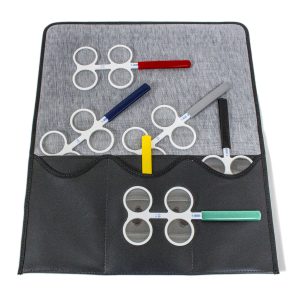 FLIPPER CASE INCLUDED. Professional level six piece set features plus/minus powers in 0.25, 0.50, 1.00, 1.50, 2.00 and 2.50 diopters. Deluxe black carrying case or the economy flipper holder included. Specify which you prefer. Flippers come with colored handle covers. Your account must be registered as a healthcare professional or a school/government in order to purchase this product.Item #: BC1270SET
FLIPPER CASE INCLUDED. Professional level six piece set features plus/minus powers in 0.25, 0.50, 1.00, 1.50, 2.00 and 2.50 diopters. Deluxe black carrying case or the economy flipper holder included. Specify which you prefer. Flippers come with colored handle covers. Your account must be registered as a healthcare professional or a school/government in order to purchase this product.Item #: BC1270SET -
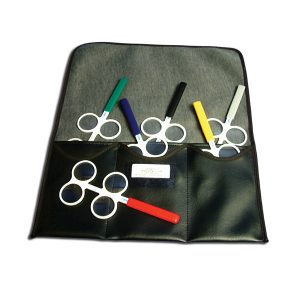 Flippers are used to test and train for accomodative facility, accommadative rock, positive/negative relative accommodation and convergence and fusional convergence reserves. May delay bifocal use with some early presbyopes. Flippers assists in hyperopia screening and lens demonstrations. Help determine dominancy and powers when fitting monovision contacts. Durable white plastic holds shape under low heat for lens insertion. Powers listed on handle. Deluxe Black carrying case or the economy flipper holder included. Item #: BC1270SETSP
Flippers are used to test and train for accomodative facility, accommadative rock, positive/negative relative accommodation and convergence and fusional convergence reserves. May delay bifocal use with some early presbyopes. Flippers assists in hyperopia screening and lens demonstrations. Help determine dominancy and powers when fitting monovision contacts. Durable white plastic holds shape under low heat for lens insertion. Powers listed on handle. Deluxe Black carrying case or the economy flipper holder included. Item #: BC1270SETSP -
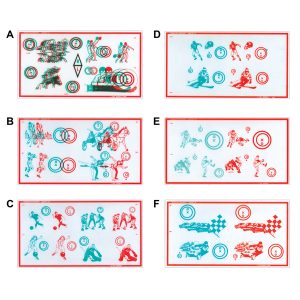 Fixed Demands Tranaglyph™ Kit (50 Series) Ideal for testing or training in true space at the office or home. Eliminates suppression while developing fusion and stereopsis. Non-variable prismatic Red/Green slides build fusional convergence & divergence. 2PD increments from 0 to 30PD BI or BO. 10" x 5.5" Red/Green targets on frosted vinyl. Can be used with Polachrome Trainer.Item #: BC50K+
Fixed Demands Tranaglyph™ Kit (50 Series) Ideal for testing or training in true space at the office or home. Eliminates suppression while developing fusion and stereopsis. Non-variable prismatic Red/Green slides build fusional convergence & divergence. 2PD increments from 0 to 30PD BI or BO. 10" x 5.5" Red/Green targets on frosted vinyl. Can be used with Polachrome Trainer.Item #: BC50K+ -
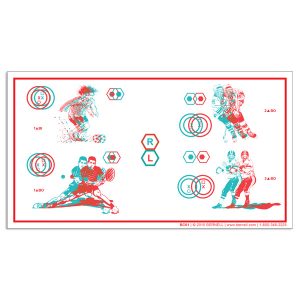
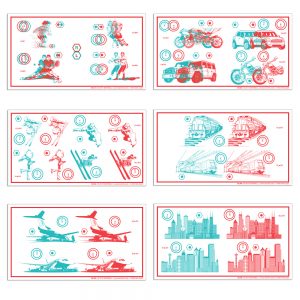 Fixed Demands Tranaglyph™ Kit (60 Series) Ideal for testing or training in true space at the office or home. Eliminates suppression while developing fusion and stereopsis. Non-variable prismatic Red/Green slides build fusional convergence & divergence. 2PD increments from 0 to 30PD BI or BO. 10" x 5.5" Red/Green targets on frosted vinyl. Can be used with Polachrome Trainer. Item #: BC60K+
Fixed Demands Tranaglyph™ Kit (60 Series) Ideal for testing or training in true space at the office or home. Eliminates suppression while developing fusion and stereopsis. Non-variable prismatic Red/Green slides build fusional convergence & divergence. 2PD increments from 0 to 30PD BI or BO. 10" x 5.5" Red/Green targets on frosted vinyl. Can be used with Polachrome Trainer. Item #: BC60K+ -
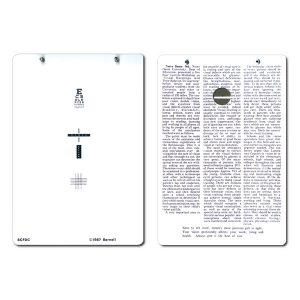 Variable slide adjust to determine fixation disparity or may be used with hand held prisms. Designed for phoroptor use. The card comes with a label which may be placed over the prism diopter scale for an additional scale in degrees. Reverse side of card includes reduced Snellen, fusional target and cross cylinder targets. 5-1/2" x 8" card and polarized goggle. Item #: BCFDC
Variable slide adjust to determine fixation disparity or may be used with hand held prisms. Designed for phoroptor use. The card comes with a label which may be placed over the prism diopter scale for an additional scale in degrees. Reverse side of card includes reduced Snellen, fusional target and cross cylinder targets. 5-1/2" x 8" card and polarized goggle. Item #: BCFDC -
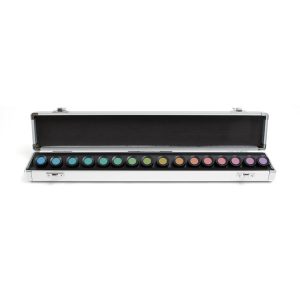 Farnsworth Test for Congenital and Acquired color defects. The Farnsworth D-15 contains a reference disc holding notation 10 B 5 4 and fifteen numbered discs which make up an incomplete color circle. The patient arranges the discs and then evaluation of the patients arrangement separates 'normal' color perception from moderate and strong defects in deutan, protan or tritan axis color discrimination. The disks are spread out on a table and arranged by the patient. The Farnsworth D-15 test is a subset of the well known Farnsworth 100 Hue Test. It is intended for classification instead of in-depth study of color vision defects. The D-15 and 100 hue tests are correlated. Growing Importance of Color deficiency Screening: In addition to congenital color deficiency screening there is growing evidence that adult acquired color deficiency, especially in yellow and blue perception, can indicate medical toxicity and other problems. Increasingly complex security and medical systems also require verification of all three types of color receptors. How the D-15 test works: The Farnsworth D15 is called 'dichotomous' because it is designed to separate subjects into one of two groups, 1) Strongly color deficient or 2) Mildly color deficient or color normal. This is accomplished by the arrangement of vivid (saturated) colored discs. A perfect score shows normal color perception. A non-perfect score is used to determine a medium or strong color deficiency.
Farnsworth Test for Congenital and Acquired color defects. The Farnsworth D-15 contains a reference disc holding notation 10 B 5 4 and fifteen numbered discs which make up an incomplete color circle. The patient arranges the discs and then evaluation of the patients arrangement separates 'normal' color perception from moderate and strong defects in deutan, protan or tritan axis color discrimination. The disks are spread out on a table and arranged by the patient. The Farnsworth D-15 test is a subset of the well known Farnsworth 100 Hue Test. It is intended for classification instead of in-depth study of color vision defects. The D-15 and 100 hue tests are correlated. Growing Importance of Color deficiency Screening: In addition to congenital color deficiency screening there is growing evidence that adult acquired color deficiency, especially in yellow and blue perception, can indicate medical toxicity and other problems. Increasingly complex security and medical systems also require verification of all three types of color receptors. How the D-15 test works: The Farnsworth D15 is called 'dichotomous' because it is designed to separate subjects into one of two groups, 1) Strongly color deficient or 2) Mildly color deficient or color normal. This is accomplished by the arrangement of vivid (saturated) colored discs. A perfect score shows normal color perception. A non-perfect score is used to determine a medium or strong color deficiency. -
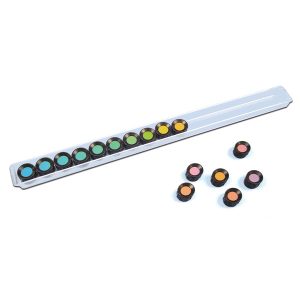 Farnsworth D15 Dichotomous Color Test Farnsworth Test for Congenital and Acquired color defects. The Farnsworth D-15 contains a reference disc holding notation 10 B 5 4 and fifteen numbered discs which make up an incomplete color circle. The patient arranges the discs and then evaluation of the patients arrangement separates 'normal' color perception from moderate and strong defects in deutan, protan or tritan axis color discrimination. The D-15 is housed in a plexiglass container. the disks are spread out on a table and arranged by the patient. The Farnsworth D-15 test is a subset of the well known Farnsworth 100 Hue Test. It is intended for classification instead of in-depth study of color vision defects. The D-15 and 100 hue tests are correlated. Growing Importance of Color deficiency Screening. In addition to congenital color deficiency screening there is growing evidence that adult acquired color deficiency, especially in yellow and blue perception, can indicate medical toxicity and other problems. Increasingly complex security and medical systems also require verification of all three types of color receptors. How the D-15 test works: The Farnsworth D15 is called 'dichotomous' because it is designed to separate subjects into one of two groups, 1) Strongly color deficient or 2) Mildly color deficient or color normal. This is accomplished by the arrangement of vivid (saturated) colored discs. A perfect score shows normal color perception. A non-perfect score is used to determine a medium or strong color deficiency.
Farnsworth D15 Dichotomous Color Test Farnsworth Test for Congenital and Acquired color defects. The Farnsworth D-15 contains a reference disc holding notation 10 B 5 4 and fifteen numbered discs which make up an incomplete color circle. The patient arranges the discs and then evaluation of the patients arrangement separates 'normal' color perception from moderate and strong defects in deutan, protan or tritan axis color discrimination. The D-15 is housed in a plexiglass container. the disks are spread out on a table and arranged by the patient. The Farnsworth D-15 test is a subset of the well known Farnsworth 100 Hue Test. It is intended for classification instead of in-depth study of color vision defects. The D-15 and 100 hue tests are correlated. Growing Importance of Color deficiency Screening. In addition to congenital color deficiency screening there is growing evidence that adult acquired color deficiency, especially in yellow and blue perception, can indicate medical toxicity and other problems. Increasingly complex security and medical systems also require verification of all three types of color receptors. How the D-15 test works: The Farnsworth D15 is called 'dichotomous' because it is designed to separate subjects into one of two groups, 1) Strongly color deficient or 2) Mildly color deficient or color normal. This is accomplished by the arrangement of vivid (saturated) colored discs. A perfect score shows normal color perception. A non-perfect score is used to determine a medium or strong color deficiency. -
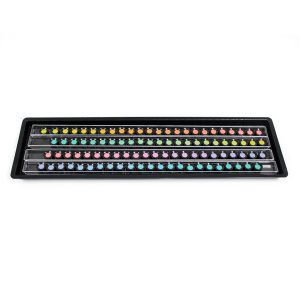 This handheld circular pupillometer device is used for measuring different size pupils. It was developed and researched by Dr. Jack Richman, O.D., as part of the Massachusetts Drug Evaluation and Classification Program (MDEP). This pupil measurement device is used by law enforcement officers across the country to assist in determining whether people are possibly impaired and/or under the influence of drugs. The reverse side has expected pupil size in different lighting conditions for non-impaired people. Item #: LV3553000
This handheld circular pupillometer device is used for measuring different size pupils. It was developed and researched by Dr. Jack Richman, O.D., as part of the Massachusetts Drug Evaluation and Classification Program (MDEP). This pupil measurement device is used by law enforcement officers across the country to assist in determining whether people are possibly impaired and/or under the influence of drugs. The reverse side has expected pupil size in different lighting conditions for non-impaired people. Item #: LV3553000 -
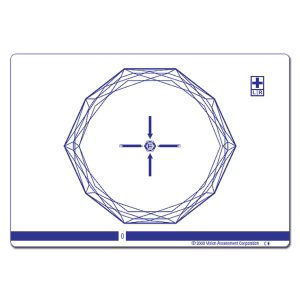 Gem Polarized Variable Vectographic with Fixation Disparity Target → Stereopsis depth of 700 seconds of arc → Includes Fixation Disparity target with central Fusion Lock → 16 diopter range for Base-In (Divergence) Training → 24 diopter range for Base-Out (Convergence) Training → Total accommodation range of 40 diopters → New improved Vecto Guides → Now includes Therapy Binder → Now includes doctor and patient instruction manuals → Now includes Patient Vision Therapy Record Form → Includes Standard Polarized Viewers Item #: VA1060PL
Gem Polarized Variable Vectographic with Fixation Disparity Target → Stereopsis depth of 700 seconds of arc → Includes Fixation Disparity target with central Fusion Lock → 16 diopter range for Base-In (Divergence) Training → 24 diopter range for Base-Out (Convergence) Training → Total accommodation range of 40 diopters → New improved Vecto Guides → Now includes Therapy Binder → Now includes doctor and patient instruction manuals → Now includes Patient Vision Therapy Record Form → Includes Standard Polarized Viewers Item #: VA1060PL -
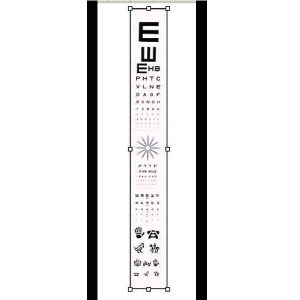 Projector Slide Replacements Family Practice Slide Letter Acuity, Astigmatic Clock, Tumbling "E", Allen Figures This family of projector slides are designed for testing all ages. Made of high quality photographic film, sealed between two pieces of glass to ensure sharp optotypes to maintain the integrity of your exam. Each slide must be adjusted for use on different length testing lanes.
Projector Slide Replacements Family Practice Slide Letter Acuity, Astigmatic Clock, Tumbling "E", Allen Figures This family of projector slides are designed for testing all ages. Made of high quality photographic film, sealed between two pieces of glass to ensure sharp optotypes to maintain the integrity of your exam. Each slide must be adjusted for use on different length testing lanes. -
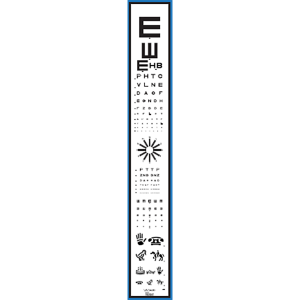 Designed for use in manual Chart Projectors including products from: R.H. Burton, Marco, Reichart, Topcon, and Woodlyn. Includes test for: → Tumbling E 20/400 – 20/200 (3 Lines) → Sloan Letters 20/100 – 20/10 (11 Lines) → Astigmatic Clock → Sloan Letters 20/50 – 20/10 (6 Lines) → Tumbling E 20/50 – 20/15 (5 Lines) → Allen Acuity 20/100 – 20/40 (4 Lines) Item #: VA1193
Designed for use in manual Chart Projectors including products from: R.H. Burton, Marco, Reichart, Topcon, and Woodlyn. Includes test for: → Tumbling E 20/400 – 20/200 (3 Lines) → Sloan Letters 20/100 – 20/10 (11 Lines) → Astigmatic Clock → Sloan Letters 20/50 – 20/10 (6 Lines) → Tumbling E 20/50 – 20/15 (5 Lines) → Allen Acuity 20/100 – 20/40 (4 Lines) Item #: VA1193 -
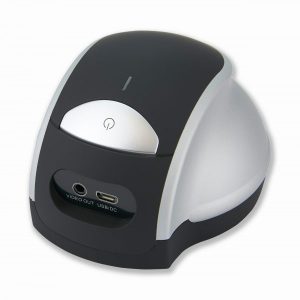
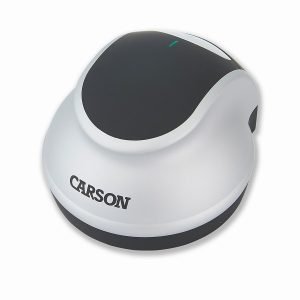 The DR-300 ezRead™ from Carson Optical transforms your television into a visual aid! Place the ezRead™ directly on top of your reading material to display the magnified image in full color on your television screen! Connect to your television in seconds using the supplied video cable. Internal led illumination ensures that the image on the screen is bright and easy to read. The size of your television monitor determines the actual magnification of the item. The larger the monitor, the greater the ezRead™ magnifies! The ezRead™ is ideal for those with low vision or macular degeneration. Operates with three AAA batteries (not included) or supplied A/C power adaptor. Magnification Table: 7x on a 17″ monitor, 11.5x on a 27″ monitor, 13.5x on a 32″ monitor, 17x on a 40″ monitor & 19.5x on a 46″ monitor
The DR-300 ezRead™ from Carson Optical transforms your television into a visual aid! Place the ezRead™ directly on top of your reading material to display the magnified image in full color on your television screen! Connect to your television in seconds using the supplied video cable. Internal led illumination ensures that the image on the screen is bright and easy to read. The size of your television monitor determines the actual magnification of the item. The larger the monitor, the greater the ezRead™ magnifies! The ezRead™ is ideal for those with low vision or macular degeneration. Operates with three AAA batteries (not included) or supplied A/C power adaptor. Magnification Table: 7x on a 17″ monitor, 11.5x on a 27″ monitor, 13.5x on a 32″ monitor, 17x on a 40″ monitor & 19.5x on a 46″ monitor

